The genito-urinary system encompasses the kidneys, ureters, bladder, urethra, testis and external genitalia. These organs can be damaged along with other internal organs when patients have suffer massive multi-systems trauma from incidents like auto accidents, industrial accidents or when patients are victims of gunshot wounds or other violent crimes.
The external genitalia and the urethra (urinary channel from the bladder) can also be damaged with site-specific trauma that can be fairly minor. Some genito-urinary injuries are managed with immediate surgery to save the life of the patients that have been the victims of trauma; other injuries are managed with observation and delayed surgery if needed in the future after healing has had time to occur.
In areas other than urban centers, most kidney injuries occur from a blunt force trauma. A common scenario would involve a high-speed auto accident. In these injuries other organ injuries and broken bones are very common. Most of these kidney injuries can be managed with careful observation. On occasion an injury is so severe that patients require immediate life-saving operations to either repair or remove the kidney. Occasional patients need other procedures like insertion of drains around the kidney or a temporary drainage tube (urinary stent) to help the kidney heal. In rare cases the kidney may need to be removed in the future because of chronic infection or loss of function. Usually the loss of one kidney does not increase the chance of kidney failure in the future.
A severe kidney trauma with the kidney split apart after a motor vehicle accident
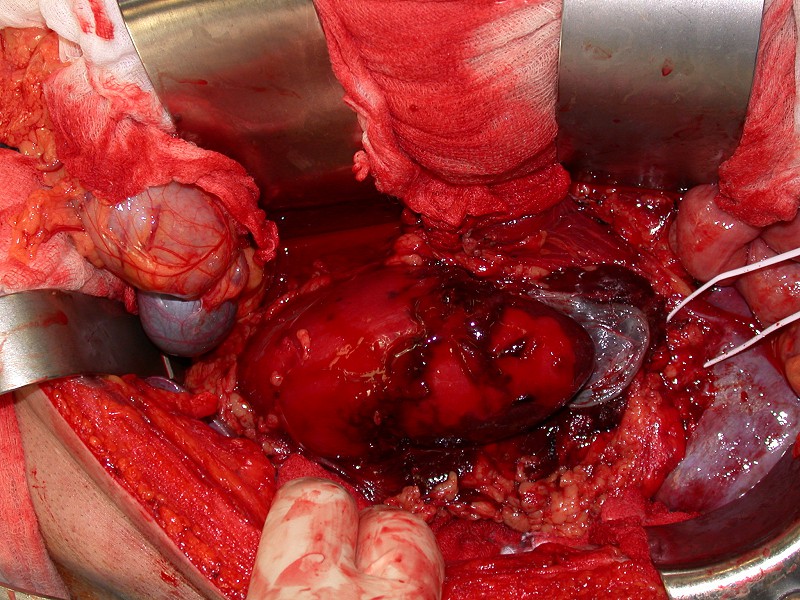
The urethra is usually injured in one of two ways. The first injury occurs during a pelvic fracture. The sheering forces of the pelvic fracture tear the urethra in half somewhere around the location of the prostate as the urethra travels towards the bladder. This is called a posterior urethral disruption. Often a procedure is done to try to realign the urethra so that it can heal together over a catheter. Other times the damage is too severe and a catheter is left in the bladder through the lower belly (suprapubic tube) and a plan is made for subsequent surgery in the future. Scarring occurs in the area where the urethra was ripped apart and usually a surgery needs to be done where this scar is removed and the healthy urethra is brought to the tip of the prostate and sewn to the other uninjured portion of the urethra. This surgery is called a posterior urethroplasty.
Urethral trauma from a pelvic fracture - the normal urethra ends with the retrograde urethrogram and there is a bloom of contrast where the urethra is severed
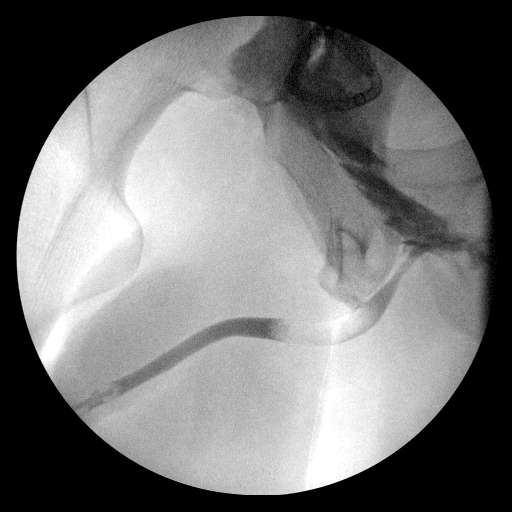
The second type of injury is called a straddle injury. In this injury a male patient falls forcefully with the legs apart on something hard. From the injury, a blow occurs to the skin between the scfrotum and the anus. Some examples of this are falling upon the crossbar of a bicycle, a railing, or being bucked onto the horn of a saddle. In this injury, the urethra is squeezed against the underside of the pubic bone and forcefully divided in two. Usually patients have a lot of bleeding from the penis and a large bruise forms in the groin and perineum (the area between the anus and the scrotum). The initial management of these injuries involves a similar strategy to pelvic fracture injuries. A catheter can be placed across the gap in hopes that the urethra will heal together or a catheter can be placed through the abdomen into the bladder (suprapubic tube) and a surgery can be done some time later to fix the scarring that develops.
Most of these traumatic injuries to the urethra can be fixed about 3-6 months after they occur. We know that fixing the injuries immediately after they occur increases the chance of recurrent scarring and also can harm erections. This is the reason for the delay for 3-6 months. During this time, patients are treated with a suprapubic catheter which is changed every 4-6 weeks in our office. In some cases, it is important to wait for complete healing of pelvic fractures and the pelvis to stabilize before surgery is performed.
The bladder can be injured either during a pelvic fracture or secondary to a forceful blow to the abdomen when the bladder is full. This very commonly can occur due to a seatbelt or a steering wheel injury during an automobile accident. Bladder injuries that open into the abdomen are closed immediately. Injuries that do not spill urine into the abdomen and only to the space around the bladder can be treated with a urinary catheter for approximately 2 weeks. Chronic problems with urinary leakage outside of the bladder into the pelvic area or the skin can occasionally occur after severe injuries. In these cases patients may need reconstructive surgery.
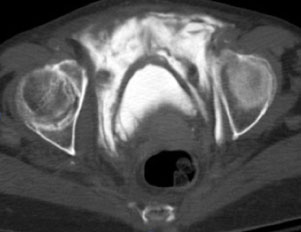
Image for a CT scan showing leakage of urine outside of the bladder into the pelvis.
One of the main causes of penile trauma is intercourse. When an injury occurs during intercourse the penile trauma is called a penile fracture. The mechanism of this injury is the erect penis comes out of the vagina and forcefully impacts the pubic bone of the partner. This force buckles the erect penis and a tear occurs in the tough outer lining (tunica albuginea) of the erectile bodies of the penis (corporal body). The penis rapidly loses its rigidity and a large bruise develops from the base of the penis to the head of the penis. A moderate amount of pain is associated with this. Occasionally the tear is so severe that the urethra (urinary channel) is also injured. Penile fractures should be repaired as soon as is practical after they occur. If they are not repaired, most urologists feel there is an increased likelihood of erectile problems and scarring in the future. To repair a penile fracture an incision is made over the area and strong stiches are used to closed the torn portions of the tough outer lining of the penile shaft. The urethra is repaired at the same time.
Rarely, the penis can be involved in a penetrating injury such as a gunshot wound or stab wound. Surgery is almost always required to repair any damage that is present.
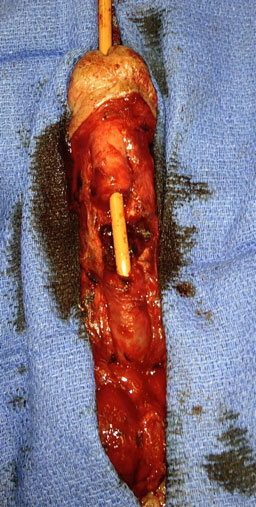
Intra-operative image of a penile fracture with a co-existing urethral injury.
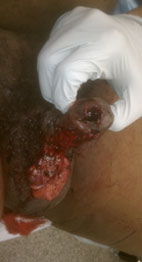
Image of penile gun shot with entry into the head of the penis with co-existing right testicular injury.
The testicle can be injured by being crushed (like being kicked forcefully) or from a penetrating injury like a gunshot wound. Usually testicular trauma is diagnosed based upon an ultrasound that shows rupture of the outside layer of the testicle (tunica albuginea). When this tough outside layer is ruptured the inside of the testicle is squished out from the testicle. The best management of this injury is to repair the testicle and remove any of the inside of the testicle that has extruded out. When the testicle is repaired patient heal much more quickly. Occasionally testicles are too damaged to repair and need to be removed.